Designed in the 1970s, the Mil Mi-24 Hind combines the functions of a gunship and troop transport, serving as a formidable weapon system. Produced by Mil Moscow Helicopter Plant, it was introduced by the Soviet Air Force in 1972 and is currently in use by 58 countries.
The Hind features a tandem cockpit configuration for the pilot and gunner, protected by thick armour and bulletproof glass. Its sleek, angular fuselage houses a 30mm automatic cannon, anti-tank guided missiles, and rocket pods, making it a versatile platform capable of engaging ground and air targets.
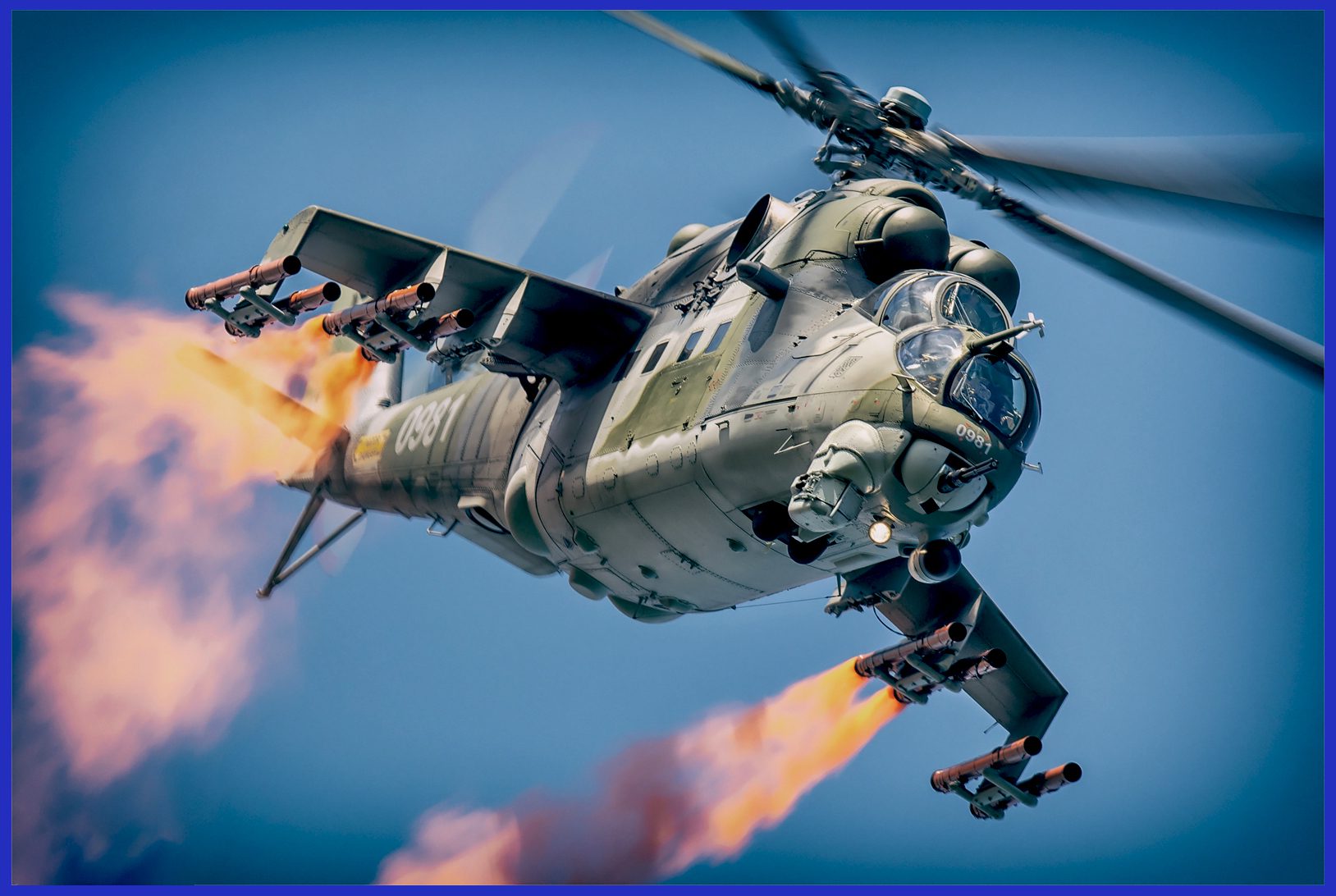
The Mi-24’s primary role is close air support, capable of providing fire support to ground forces and infantry. Its troop-carrying capacity can transport up to eight fully equipped soldiers, facilitating rapid deployment and extraction in combat zones. With impressive speed and agility, the Mi-24 remains an enduring symbol of military prowess and has been used in various conflicts worldwide.
Its robust design and adaptability continue to make it a vital asset in modern military arsenals. It is still considered one of the best combat helicopters ever created and has a significant impact on soldiers’ morale whenever they embark on combat sorties to support ground troops.
The engines and dynamic systems were largely taken from the Mi-8. Early Mi-24s had a large ‘glasshouse’ cockpit with a 12.7 mm machine gun in the nose, but the later Mi-24D had bubble cockpits and a chin-mounted turret. The Mi-24V is an upgraded version with improved systems. Alternative weapons are used in the Mi-24P and Mi-24VP. The Mi-24K is for army reconnaissance, while the Mi-24PS is for police support operations. The latest generation Mi-25 and Mi-35 are export versions.

Origin of the Mi-24 Hind
It was first used by the Soviet Air Force in 1972 and is manufactured by Mil Moscow Helicopter Factory. Soviet pilots called the Mi-24 the “Flying Tank” 58 nations are currently using the helicopter. Including The Indian Air Force with 15 of them.

Development of the Mi-24 Hind
The Mi-24 Hind is a renowned Soviet/Russian helicopter gunship and troop transport that underwent development in the late 1960s. This remarkable aircraft was conceived and designed by the Mil Moscow Helicopter Plant, with the leadership of Mikhail Mil. The comprehensive design process commenced in August 1968, operating under the codename Yellow 24. In February 1969, a full-scale mock-up of the design was subject to review and received approval.
Subsequently, flight testing with a prototype commenced on September 15, 1969, initially involving tethered hovering. Four days later, the aircraft achieved its first free flight. Following this milestone, a second prototype was constructed, and it was succeeded by a test batch of ten helicopters.

Acceptance testing for the design commenced in June 1970 and spanned a duration of 18 months. Various alterations were introduced to address issues related to structural strength, fatigue, and vibration levels within the design. Additionally, a 12-degree anhedral angle was incorporated into the wings to counterbalance the aircraft’s tendency to experience Dutch roll when exceeding speeds of 200 km/h (124 mph).
The Falanga missile pylons underwent relocation from the fuselage to the wingtips. The tail rotor was repositioned from the right to the left side of the tail, accompanied by a reversal in its rotation direction.

This adjustment led to the tail rotor rotating upward on the side facing the front of the aircraft, placing it within the downwash of the main rotor, subsequently enhancing its efficiency. Several other design modifications were implemented until the production version, the Mi-24A, commenced production in 1970. It attained its initial operating capability in 1971 and received official acceptance into the state arsenal in 1972.
In 1972, after the Mi-24 project concluded, a new development effort began for an exceptional attack helicopter with transport capabilities. The Mi-24 blended the characteristics of a heavily armed attack helicopter with those of a troop transport, resulting in a distinctive combination of firepower and transport capacity. Its unique tandem rotor design and sleek fuselage led to it being affectionately dubbed the ‘Hind,’ owing to its resemblance to the Indian antelope.
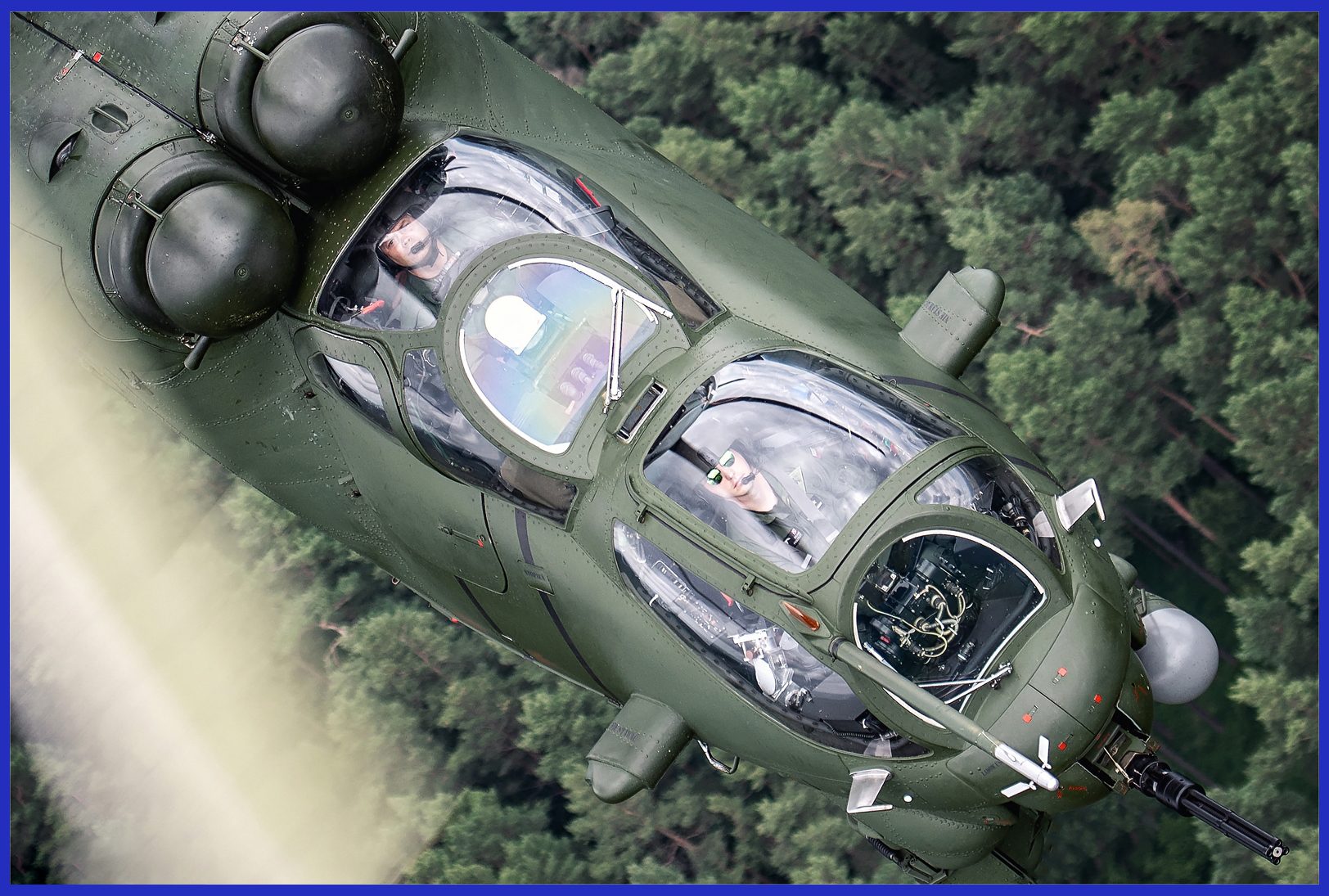
The appearance of this new helicopter in East Germany in 1974 heralded a fantastic strengthening of the only area in which Soviet forces had previously been outclassed by those of the United States. The Mi-24 is a substantial machine of the same size and power class as the later Sikorsky UH-60 Black Hawk. Since 1974 a number considerably exceeding 1000 have gone into service mainly with Air Armies in occupied countries of Eastern Europe.
For ten years production at two plants in Russia, Arsenyev and Rostov has exceeded 15 per month. Over 350 have been exported outside the Warsaw Pact.
During the Cold War, the Mi-24 served as a vital asset in various conflicts worldwide, such as Afghanistan and Angola. It was known for its ability to carry a significant payload of weapons, including rockets, missiles, and machine guns. The Mi-24 underwent several upgrades over the years, resulting in different variants with improved avionics and weapons systems. Its versatility and ruggedness have allowed it to remain in service with numerous countries and continue its role as a symbol of Soviet-era military aviation prowess.
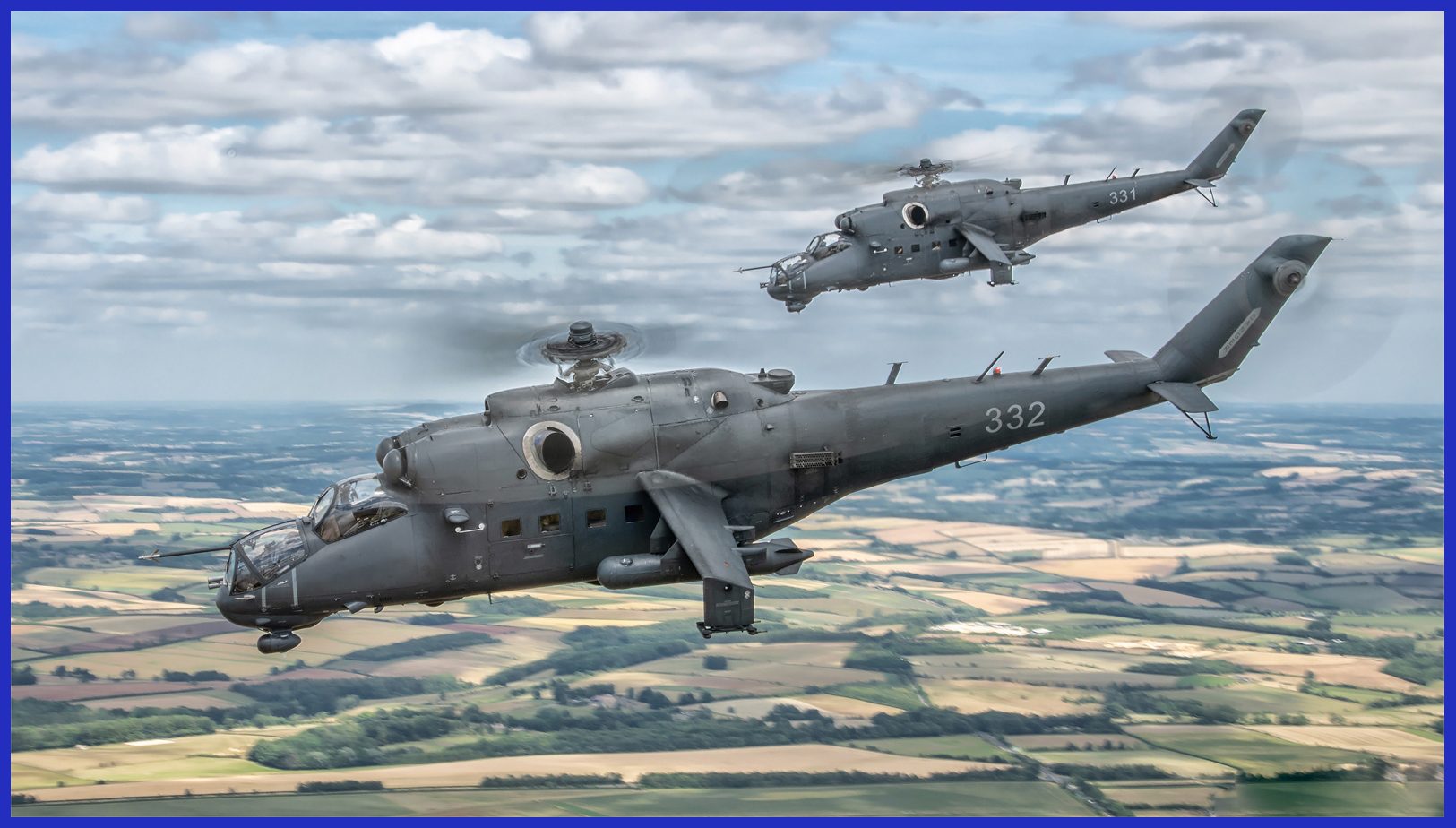
Design of the Mi-24 Hind
The aircraft’s basic design was based on the Mil Mi-8 (NATO reporting name “Hip”), which has two top-mounted turboshaft engines that power a 17.3 m, five-blade main rotor positioned in the middle and a three-blade tail rotor mounted on the bottom. The aircraft’s unusual double air inlet resulted from the engine setup. The cockpit on the original models is angular, like a greenhouse, but the cockpit on Model D and later models has a distinctive tandem design with a “double bubble” canopy. The Mi-14 “Haze” provided additional parts for the airframe.
Each of the two mid-mounted stub wings has three stations for a weapon hardpoint in addition to providing lift. Mi-24s can be used for close air support, anti-tank missions, or aerial warfare, depending on the objective.
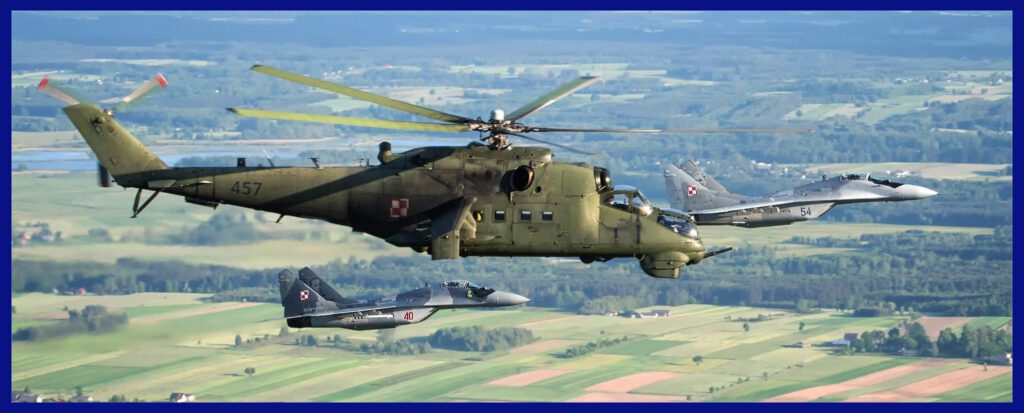
The titanium rotor blades on the Mi-24 can withstand 12.7 mm bullets. A titanium-armoured tub and ballistic-resistant windscreens provide protection for the cockpit. The crew’s protection in NBC ( Nuclear, Biological and Chemical) circumstances is provided by overpressurizing the cockpit and crew compartment.
No other helicopter combines the weapons, sensors, armour and flight performance of this family, to say nothing of adding a cabin for eight troops or four stretcher casualties or urgent front-line cargo. The main rotor has a fully articulated hub of machined steel, with the usual hydraulic lead/leg dampers, and retains the blades by usually short coupling links. These are bolted to the extruded multiple spears of titanium alloy, around which are bounded the honey-comb-filled glass-fibre skins.
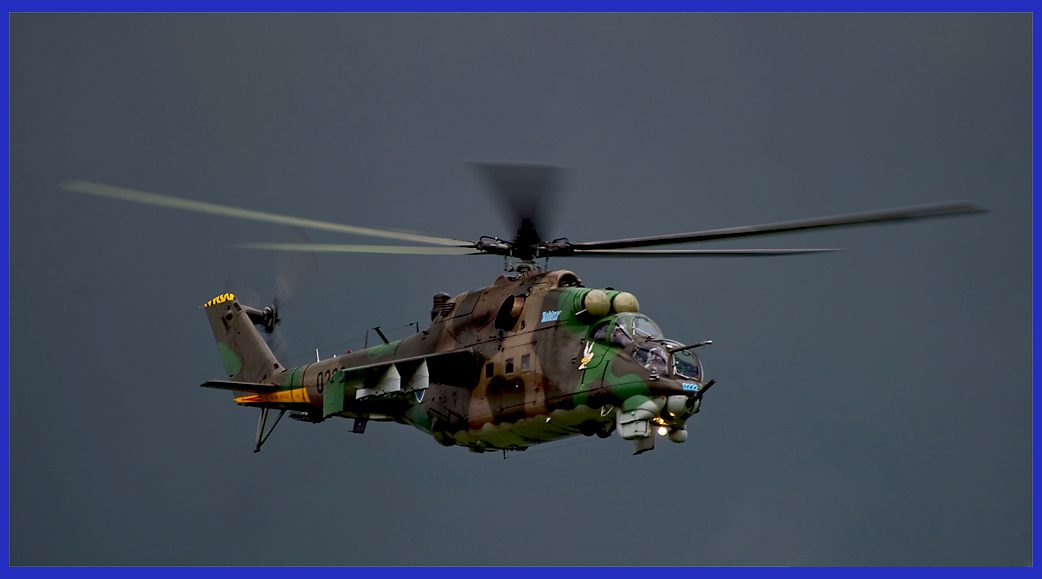
The leading edge of each blade has an anti-erosion strip and electrothermal deicing, and a balance tab is fitted to the outer trailing edge. The tail rotor has three aluminium alloy blades except for the first Mi-24 version. Its tricycle landing gears are fully retractable. All versions have extensive armour protection.
As a combination of the armoured gunship and troop transport, the helicopter has no direct NATO counterpart. While the US used the UH-1 (“Huey”) helicopters to ferry troops or as gunships in the Vietnam War, they could not do both at the same time. Converting a UH-1 into a gunship meant stripping the entire passenger area to accommodate extra fuel and ammunition, and removing its troop transport capability.
The Soviet Army’s airborne forces made extensive use of the Mi-24’s ability to perform both during the 1980–1989 Soviet–Afghan War. The American Sikorsky S-67 Blackhawk, which employed many of the same basic ideas, served as the closest Western analogue.

Mil Mi-24 Hind: Specifications Unveiled
- Crew: 2 ( pilot and gunner )
- Capacity: 8 troops, 4 stretchers, or an external sling load of up to 2,400 kg ( 5,291 lb )
- Length: 60 ft 8 in ( 18.5 m )
- Height: 21 ft 4 in ( 6.5 m )
- Wingspan: 21 ft 4 in ( 6.5 m )
- Weight: empty_ 6500 kg ( 14,300 lb ) / Max loaded_ 11,500 kg ( 25,400 lb )
- Power plant: 2 × Isotov TV3-117 turboshaft engines, 1,600 kW (2,200 shp) each
- Main rotor diameter: 17.3 m (56 ft 9 in)
- Maximum Speed: 350 km/h
- Range: 450 km ( operational _ 160 km )
- Service ceiling: 7,220 ft ( 2200 m )
- Rate of climb: 2,953 ft/m ( 900 m/min )
- Armament: Internal: The aircraft features a flexible 12.7 mm Yakushev-Borzov Yak-B Gatling gun on most variants, with a maximum of 1,470 rounds of ammunition. Additionally, it is equipped with a flexible GIAT dual-feed 20mm (M693) autocannon on Mi-24 SuperHind Mk.II/III/IV/V, which carries 320 rounds of ammunition. Moreover, it has window-mounted machine guns. External armament includes various types of 2nd Gen Rockets and anti-tank missiles.
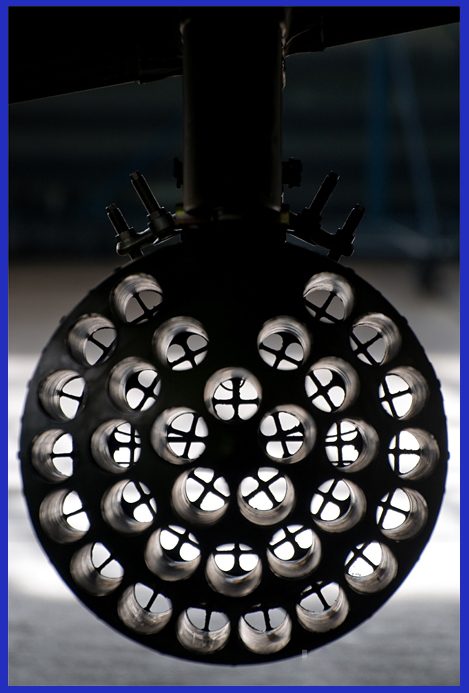
Furthermore, seize the exclusive opportunity to acquire these exquisite large-scale 1/72 premium die-cast models of the formidable SU-30SM Russian Knights. These remarkable military Sukhoi fighters, part of the Russian aerobatic team, are available now on AirModels, embodying unparalleled craftsmanship and attention to detail. Don’t hesitate to click here and secure these exceptional models before our limited stock runs out.

In conclusion, the Mi-24 Hind stands as an enduring symbol of innovation and versatility in military aviation. Born during the Cold War era, this iconic helicopter seamlessly melded the roles of a gunship and troop transport, redefining battlefield capabilities. Its distinctive appearance and formidable firepower left an indelible mark on both the aviation industry and the pages of history.
Throughout its service life, the Mi-24 adapted and evolved, continuing to prove its worth in numerous conflicts around the world. Its enduring legacy is a testament to the ingenuity of its designers and the resilience of its design. As it continues to serve in various capacities across the globe, the Mi-24 Hind remains a symbol of the enduring impact of Soviet-era engineering and its enduring relevance in modern military operations.

Important Announcement for Our Valued Readers!
After an article is published, it is possible that updates or changes may have occurred beyond the time of publication. Therefore, it is important to be aware that certain information in the article might be outdated. To ensure the most accurate analysis, it is highly recommended to verify the content with the latest sources available.
However, we are dedicated to delivering outstanding articles on military products and global updates. Maintaining quality and smooth operation requires resources. Your support sustains our efforts in providing insightful content. By purchasing high-quality products through our affiliated links, you help us keep our platform alive and acquire top-notch items. Your unwavering support is invaluable and inspires us to strive further.
We welcome your suggestions and requests for more information, as we value feedback from our readers. If there’s specific defence material or equipment not covered on our site, please share your request in the comments. We’ll strive to research and provide the required information. We sincerely thank you for your unwavering interest in our website, and we eagerly anticipate hearing from you! Enjoy your reading experience!
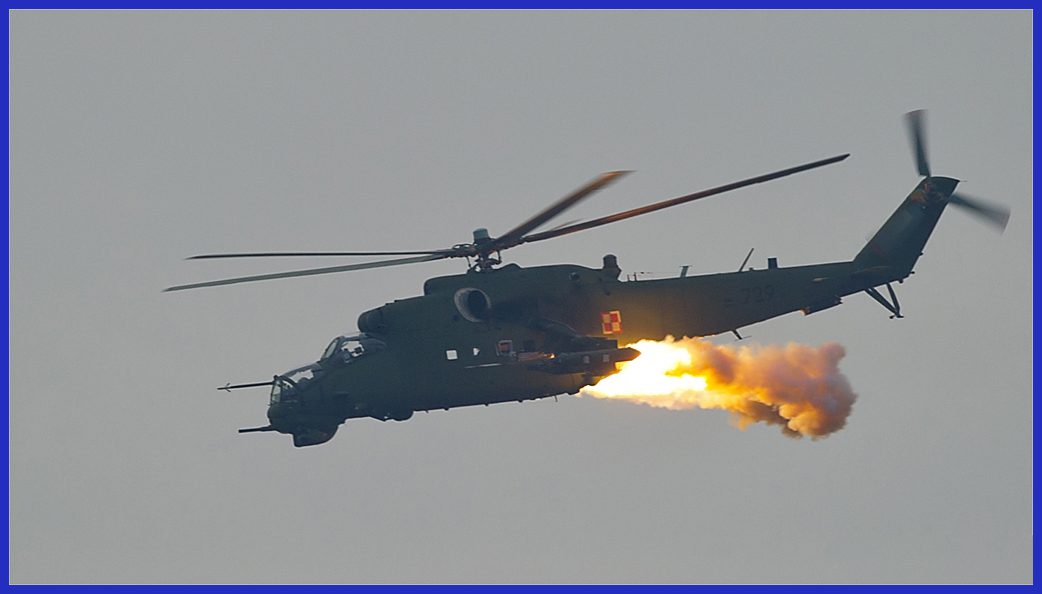

2 thoughts on “Mil Mi-24 Hind”